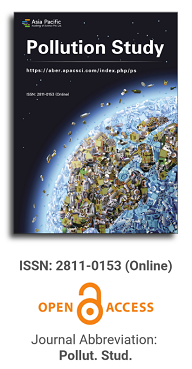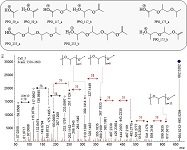
Asia Pacific Academy of Science Pte. Ltd. (APACSCI) specializes in international journal publishing. APACSCI adopts the open access publishing model and provides an important communication bridge for academic groups whose interest fields include engineering, technology, medicine, computer, mathematics, agriculture and forestry, and environment.

The (partial) replacement of synthetic polymers with bioplastics is due to increased production of conventional packaging plastics causing for severe environmental pollution with plastics waste. The bioplastics, however, represent complex mixtures of known and unknown (bio)polymers, fillers, plasticizers, stabilizers, flame retardant, pigments, antioxidants, hydrophobic polymers such as poly(lactic acid), polyethylene, polyesters, glycol, or poly(butylene succinate), and little is known of their chemical safety for both the environment and the human health. Polymerization reactions of bioplastics can produce no intentionally added chemicals to the bulk material, which could be toxic, as well. When polymers are used to food packing, then the latter chemicals could also migrate from the polymer to food. This fact compromises the safety for consumers, as well. The scarce data on chemical safety of bioplastics makes a gap in knowledge of their toxicity to humans and environment. Thus, development of exact analytical protocols for determining chemicals of bioplastics in environmental and food samples as well as packing polymers can only provide warrant for reliable conclusive evidence of their safety for both the human health and the environment. The task is compulsory according to legislation Directives valid to environmental protection, food control, and assessment of the risk to human health. The quantitative and structural determination of analytes is primary research task of analysis of polymers. The methods of mass spectrometry are fruitfully used for these purposes. Methodological development of exact analytical mass spectrometric tools for reliable structural analysis of bioplastics only guarantees their safety, efficacy, and quality to both humans and environment. This study, first, highlights innovative stochastic dynamics equations processing exactly mass spectrometric measurands and, thus, producing exact analyte quantification and 3D molecular and electronic structural analyses. There are determined synthetic polymers such as poly(ethylenglycol), poly(propylene glycol), and polyisoprene as well as biopolymers in bags for foodstuffs made from renewable cellulose and starch, and containing, in total within the 20,416–17,495 chemicals per sample of the composite biopolymers. Advantages of complementary employment in mass spectrometric methods and Fourier transform infrared spectroscopy is highlighted. The study utilizes ultra-high resolution electrospray ionization mass spectrometric and Fourier transform infrared spectroscopic data on biodegradable plastics bags for foodstuffs; high accuracy quantum chemical static methods, molecular dynamics; and chemometrics. There is achieved method performance |r| = 0.99981 determining poly(propylene glycol) in bag for foodstuff containing 20,416 species and using stochastic dynamics mass spectrometric formulas. The results highlight their great capability and applicability to the analytical science as well as relevance to both the fundamental research and to the industry.
Quantifying ecological toxicity from real heavy metal co-contamination in site soil
Vol 4, Issue 1, 2023
Download PDF
Abstract
This summary outlines a significant challenge in ecological risk assessment of contaminated sites: quantitatively evaluating the ecological effects of combined heavy metal pollution in real-world soil. The study proposes a novel quantitative ecological assessment approach that integrates both broad (“top-down”) and detailed (“bottom-up”) knowledge. This approach involves three key steps: identifying effective biomarkers, pinpointing dominant pollutants, and assessing the combined effects of various exposure types and contaminants. To validate this approach, researchers examined an abandoned electronic waste site in Jiangsu Province using soil microcosms with earthworms. By analyzing biomarkers such as malondialdehyde (MDA), metallothionein (MT), catalase (CAT), superoxide dismutase (SOD), and reduced glutathione (GSH), they found that earthworms accumulated heavy metals in the order of Cd > Cu > Zn > Ni > Pb > Cr. Principal component analysis (PCA) identified GSH, CAT, and MDA as effective biomarkers, with Cd and Zn as the primary contaminants. The study revealed significant linear relationships between biomarker changes and specific heavy metal concentrations in soil (e.g., GSH with total Cd and DTPA-extractable Zn, MDA with DTPA-extractable Cd, and CAT with total Zn and bioaccumulated Zn). The sensitivity of the biomarkers to heavy metal contamination was ranked as GSH > CAT > MDA. Furthermore, the study highlighted complex interactions among different heavy metals, exposure types (e.g., soil vs. bioaccumulated), and biomarkers, emphasizing the need for comprehensive assessments in contaminated site evaluations.
Keywords
References
- Luo YM. Contaminated site remediation in China: Progresses, problems and prospects. The Administration and Technique of Environmental Monitoring. 2011; 23(3): 1-6.
- The Ministry of Environmental Protection and the Ministry of Land and Resources of the People’s Republic of China. Bulletin on Investigation of Land and Soil Pollution China’s environmental protection industry. The Ministry of Environmental Protection and the Ministry of Land and Resources of the People’s Republic of China; 2014. pp. 10-11.
- Chen ZL, Zhao SH, Zhou JM, et al. Pollution characteristics and ecological risk assessment of heavy metals in contaminated site of a typical electroplating factory (Chinese). Environmental Pollution & Control. 2013; 35(10): 1-4,11.
- Xue CJ, Fang ZQ, Wang W. Review on remediation technology of composite polluted soil in electronic waste dismantling site (Chinese). Environmental Pollution & Control. 2021; 43(1): 103-108.
- Wang ME, Ding SK, Guo GL, et al. Advances in ecological risk assessment of soil in contaminated sites (Chinese). Chinese Journal of Applied Ecology. 2020; 31(11): 3946-3958.
- Beyer J, Petersen K, Song Y, et al. Environmental risk assessment of combined effects in aquatic ecotoxicology: A discussion paper. Marine Environmental Research. 2014; 96: 81-91. doi: 10.1016/j.marenvres.2013.10.008
- Li X, Wang M, Jiang R, et al. Evaluation of joint toxicity of heavy metals and herbicide mixtures in soils to earthworms (Eisenia fetida). Journal of Environmental Sciences. 2020; 94: 137-146. doi: 10.1016/j.jes.2020.03.055
- Li X. Ecological effects of combined pollution of heavy metals and chlorsulfuron in urban soil on earthworms. Hefei: University of Science and Technology of China, 2018: 9-10
- Davis BNK, French MC. The accumulation and loss of organochlorine insecticide residues by beetles, worms and slugs in sprayed fields. Soil Biology and Biochemistry. 1969; 1(1): 45-55.
- Zheng LP, Wang GQ, Lin YS, et al. Evaluation of toxicity effects of heavy metal contaminated soils on earthworm (Eisenia foetida) in a mining area of Guizhou Province (Chinese). Asian Journal of Ecotoxicology. 2015; 10(2): 258-265.
- Li X, Wang M, Chen W, et al. Ecological risk assessment of polymetallic sites using weight of evidence approach. Ecotoxicology and Environmental Safety. 2018; 154: 255-262. doi: 10.1016/j.ecoenv.2018.02.047
- Wang K. The ecological adaptability and detoxification mechanisms of earthworm in long-term heavy metal contaminated soil (Chinese). Beijing: China Agricultural University; 2018. pp. 66-86.
- Beaumelle L, Hedde M, Vandenbulcke F, et al. Relationships between metal compartmentalization and biomarkers in earthworms exposed to field-contaminated soils. Environmental Pollution. 2017; 224: 185-194. doi: 10.1016/j.envpol.2017.01.078
- Yan ZG, He QL, Li FS. The use of earthworm ecotoxicological test in risk assessment of soil contamination (Chinese). Research of Environmental Sciences. 2007; 20(1): 134-142.
- Ministry of Ecology and Environment of the People’s Republic of China Technical Guidelines for Investigation of Soil Pollution on Construction Land: HJ 25.1—2019. Beijing: Ministry of Ecology and Environment of the People’s Republic of China; 2019.
- Ministry of Ecology and Environment of the People’s Republic of China Determination of soil pH by potentiometric method: HJ 962—2018. Beijing: China Environmental Science Press; 2018.
- International Organization for Standardization (ISO). Soil quality. Determination of organic and total carbon after dry combustion (elementary analysis): ISO 10694—1995. Geneva: ISO; 1995.
- Ministry of Environmental Protection of the People’s Republic of China Determination of soil cation exchange capacity Cobalt hexachloride extraction spectrophotometry: HJ 889—2017. Beijing: China Environmental Science Press; 2017.
- Ministry of Environmental Protection of the People’s Republic of China Determination of 8 available elements in soil by diethylenetriamine pentaacetic acid extraction inductively coupled plasma atomic emission spectrometry: HJ 804—2016. Beijing: China Environmental Science Press; 2016.
- Wang ME, Peng C, Chen WP. Impacts of industrial zone in arid area in Ningxia Province on the accumulation of heavy metals in agricultural soils (Chinese). Environmental Science. 2016; 37(9): 3532-3539.
- State Health and Family Planning Commission, State Food and Drug Administration Determination of multi elements in food of national food safety standard: GB 5009.268—2016. Beijing: China Standards Press; 2017.
- Zuur AF, Ieno EN, Elphick CS. A protocol for data exploration to avoid common statistical problems. Methods in Ecology and Evolution. 2009; 1(1): 3-14. doi: 10.1111/j.2041-210x.2009.00001.x
- Fu XY, Qin S, Yang L, et al. Effects of earthworm accumulation of heavy metals in soil matrix (Chinese). Journal of Agro-Environment Science. 2009; 28(1): 78-83.
- Nannoni F, Rossi S, Protano G. Soil properties and metal accumulation by earthworms in the Siena urban area (Italy). Applied Soil Ecology. 2014; 77: 9-17. doi: 10.1016/j.apsoil.2014.01.004
- Wang K, Qiao Y, Zhang H, et al. Bioaccumulation of heavy metals in earthworms from field contaminated soil in a subtropical area of China. Ecotoxicology and Environmental Safety. 2018; 148: 876-883. doi: 10.1016/j.ecoenv.2017.11.058
- Dai J. Heavy metal accumulation by two earthworm species and its relationship to total and DTPA-extractable metals in soils. Soil Biology and Biochemistry. 2004; 36(1): 91-98. doi: 10.1016/j.soilbio.2003.09.001
- Ernst G, Zimmermann S, Christie P, et al. Mercury, cadmium and lead concentrations in different ecophysiological groups of earthworms in forest soils. Environmental Pollution. 2008; 156(3): 1304-1313. doi: 10.1016/j.envpol.2008.03.002
- Chen X, Wang X R, Ji R. Bioaccumulation and oxidative stresses of cadmium in earthworm Eisenia foetida in a paddy soil (Chinese). Journal of Agro-Environment Science. 2015; 34(8): 1464-1469.
- Becquer T, Dai J, Quantin C, et al. Sources of bioavailable trace metals for earthworms from a Zn-, Pb- and Cd-contaminated soil. Soil Biology and Biochemistry. 2005; 37(8): 1564-1568. doi: 10.1016/j.soilbio.2005.01.007
- Traudt EM, Ranville JF, Meyer JS. Acute Toxicity of Ternary Cd–Cu–Ni and Cd–Ni–Zn Mixtures to Daphnia magna: Dominant Metal Pairs Change along a Concentration Gradient. Environmental Science & Technology. 2017; 51(8): 4471-4481. doi: 10.1021/acs.est.6b06169
- Xu XQ, Guo P, Wang XJ, et al. Progress on CA and IA models in combined toxicity prediction of chemical mixtures (Chinese). Progress in Veterinary Medicine. 2020; 41(4): 91-94.
- Wang QL, Wang HY, Wang SR. Assessment of the state of oxidative stress (Chinese). Chinese Journal of Pathophysiology. 2005; 21(10): 2069-2074.
- van der Oost R, Beyer J, Vermeulen NPE. Fish bioaccumulation and biomarkers in environmental risk assessment: A review. Environmental Toxicology and Pharmacology. 2003; 13(2): 57-14.
Supporting Agencies
Copyright (c) 2023 Zhe Ma, Meie Wang, Rong Jiang, Weiping Chen
License URL: http://creativecommons.org/licenses/by/4.0/

This site is licensed under a Creative Commons Attribution 4.0 International License (CC BY 4.0).
.jpg)
Beijing University of Technology, China



